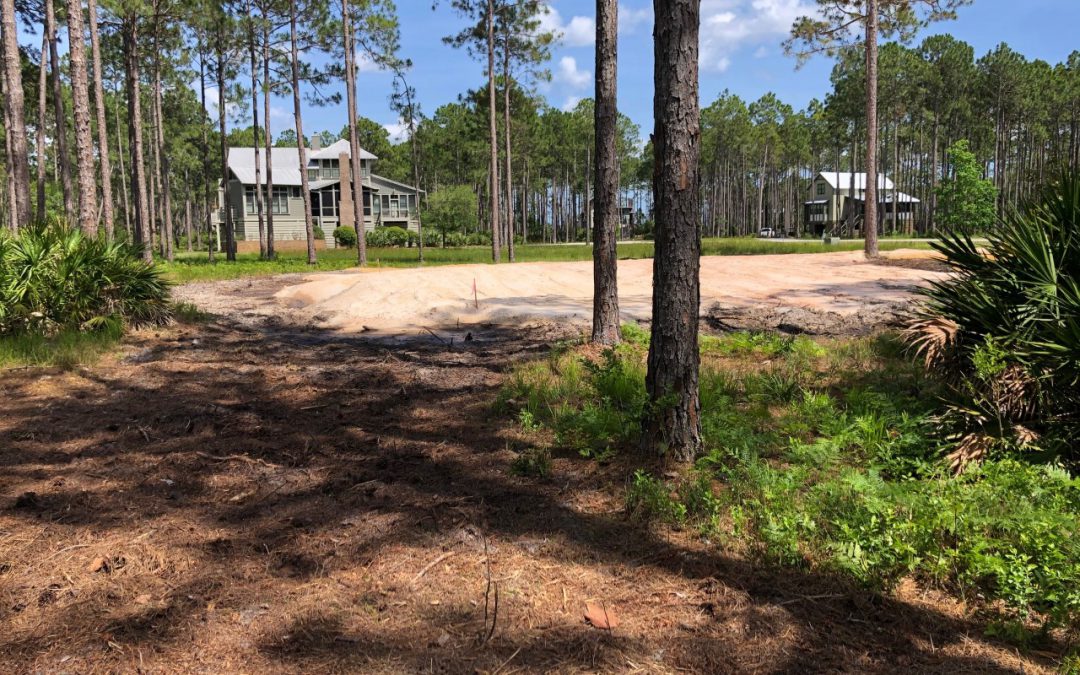
by Stephen Greer | May 27, 2021
As we have all observed communities are growing in the Panhandle through new home construction or through renovation of existing properties. This article will address new home construction. Many questions come to mind as construction begins with some of these questions needing to be addressed prior to start of construction. Determining impacts on the plant resources that already exist on the site should be included in the planning, design, construction and post-construction phases to be successful in achieving a healthy vibrant landscape for all to enjoy.

Photo Courtesy: Stephen Greer
Homes in community developments are being located on smaller lots in groups with conservation areas saved for the open spaces for all to enjoy. An older term for this was new urbanism and now is often referred to as conservation or clustered development. This type of development identifies and encourages environmentally friendly habitats for plants and animals creating a biodiversity within a walkable neighborhood designed to protect yet allow residence to enjoy some of the Northwest Florida beauty.
How can the objectives of building the new home desired, manage to protect the healthy plants already existing on the site? These challenges are difficult to answer but there are steps to accomplish both. For this article I will address construction and tree protection.
Protecting existing trees during the construction and post-construction phases takes expertise and a plan. First, consider hiring a professional arborist or urban forester to assist in this plan development. Understanding the existing trees on site prior to construction from the variety, location, visual impacts, size, overall health and location on the property are a good start. How do you protect the selected trees? First identify the trees that will need to be removed. Look for unhealthy stressed trees, significant limb death already occurring, poor crown growth (thinning) and other observations.

Photo Courtesy: Stephen Greer
The next step is to make a sight plan that needs to include grading needs for the home, drainage on the property, existing trees and surrounding vegetation, property lines, set back requirements, driveway location, utility placements and site of home. Flag trees that will be impacted and will need to be removed during the construction.
Following the sight plan, a tree protection plan needs to occur. This must happen before construction begins and include all parties involved to make sure all are in agreement. This is the stage where the group can identify conflicts involving tree protection and construction. Oversight by the owner, contractor and equipment operators is critical. A tree protection zone must be identified and implemented before construction. This typically involves setting up a fence around the protected trees and vegetation to restrict access of equipment and potential damage to the root system. A rule of thumb is to maintain a radius of at least 1.25 feet of protected area for each 1 inch of tree trunk diameter. An example would be a 12-inch diameter tree trunk with good protection at 15 feet to best protection at 30 feet of radius.
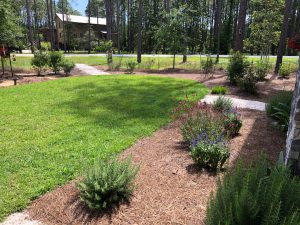
Photo Courtesy: Stephen Greer
The point is to give the best chance of a health survival of the tree during this soil and site disturbance as the construction process progress all the way to post construction with the removal of the protective fencing. Difficult decisions may need to be made of selecting trees to protect but will be needed. Enjoy the successes and plan for creating a new landscape that includes part of conserving plants that were there before and going forward.

by Carrie Stevenson | Apr 15, 2021
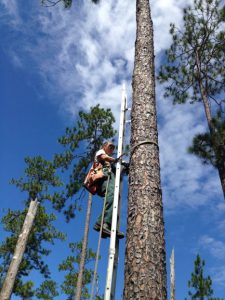
A biologist with Blackwater State Forest checks longleaf pines for signs of red cockaded woodpecker nests. Photo credit: Carrie Stevenson, UF IFAS Extension
Longleaf pine is a granddaddy among the trees of the Southeastern United States, once covering up to 90 million acres throughout the coastal plain. Tall and stately, slow-growing and dense, it was one of the most desirable trees in the forestry and shipbuilding industry for two centuries. Its sap was used to produce turpentine, tar, and pitch, especially to coat and waterproof the bottoms of wooden ships. Its tall, upright form made for a perfect ship’s mast. Between the years 1830 and 1935, approximately 90% of the Southeast’s old growth longleaf trees were harvested, and much of the land was used for farming or development.
Besides its commercial uses, the longleaf ecosystem supports a wide diversity of other plants and animals. The endangered red-cockaded woodpecker nests only in the wood of old (100-500 years!) longleaf pines, and the canopy shades a grassy groundcover often dominated by wiregrass. Gopher tortoises, the endangered indigo snake, and quail also thrive in longleaf pine ecosystems.

A longleaf pine in its grass stage. Photo credit: Carrie Stevenson, UF IFAS Extension
The longleaf pine is highly adapted to fire while in its “grass” stage and as an older tree, allowing it to tower over smaller hardwoods that are cleared out in natural and prescribed fires. This clearing allows its own seeds to sprout and thrive, and for low-growing grasses to dominate the understory. Pines can be difficult to differentiate in the southern forest, but longleaf pines have deep (up to 8-12 feet) taproots and long needles—up to 18 inches—in fascicles of two or three. The needles grow in spherical bunches that look like cheerleading pom poms.
As ecologists and foresters have realized the important role these trees play in the landscape, significant efforts have been undertaken to restore much of that habitat on both public and private land. Locally, Blackwater State Forest and neighboring Eglin Air Force Base have replanted and managed thousands of acres of longleaf habitat. Foresters and nonprofits also work with private landowners to reestablish these stately pines.
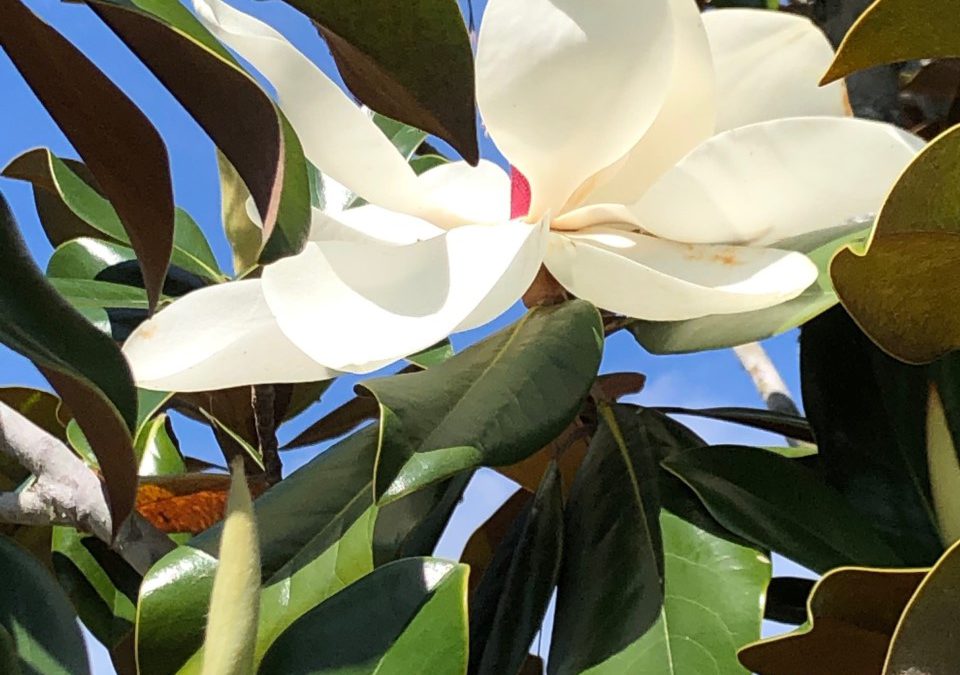
by Stephen Greer | Apr 15, 2021
There is a tall stately tree that can be found throughout the southeastern states, native in nature with a lustrous green leaf the southern magnolia is like no other tree. This amazing tree can be found from the edge of deep woodlands to the back of the tall sand dunes in the panhandle of Florida, all the way down the Florida Peninsula. The leaves provide a consistent evergreen providing a year-round presence in the landscape. Spring brings up small plate sized creamy white blooms with a wonderful fragrance with multiple blooms opening over 3 to 5 weeks. The magnolia can serve as a specimen tree or a back drop to allow other plants to be enjoyed.
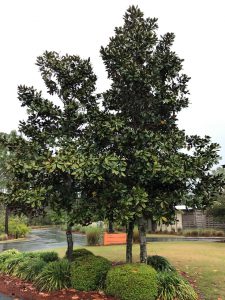
Magnolia Tree in the Landscape. Photo courtesy Stephen Greer
Often the magnolia is envisioned to be this 80-foot tall by 40-foot-wide tree with an upright pyramidal shape with the branches reaching to the ground and up to 8-inch-long shiny green leaves. There are other shapes and sizes in the landscape industry that have been found in many different ways from seedling research that has taken place at several of our land grant universities including the University of Florida. Other magnolia with different growth and bloom habits have been found growing in nature. Below are a few of these exceptional species that were selected by the keen eye of a nurseryman or a plant specialist. Next come decades of field grown observation to determine if the plant characteristics are consistent with cuttings taken and rooted to grow more trees. This is one way to see if the same look and growth continues in multiple plants.
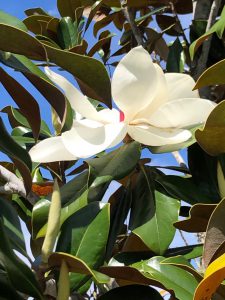
Magnolia Bloom. Photo courtesy Stephen Greer
If you grow trees from collected seeds, the new seedlings will show variable growth patterns and likely not present a consistent growth or leaf form from tree to tree. This is the reason for taking cuttings from a magnolia with the desired growth habit, leaf size and color, bloom color and fragrance.
Several cultivars have risen to the top in popularity in the landscape industry over the last 30 to 40 years. One of the most popular large magnolias is ‘Bracken’s Brown Beauty’. It was selected in a seedling field when one of the universities had completed research and invited a local nurseryman to come take any he wanted before the field was turned under for other plant research. Many were dug and field planted at the nursery with one showing many desired characteristics. With its dark rusty brown lower leaf and deep green top. It was observed for a number of years with cuttings taken. One major observation was its tolerance to cold weather. They had a winner and began to introduce it into the plant industry. ‘Little Gem’ is another magnolia that is quite popular for its dwarf (slower) upright growth habit. It first was considered a hedge plant with a dense leaf canopy from bottom to top. The challenge is the plant density opens up as it matures with it ultimately reaching approximately 30-foot tall by 20-foot wide. The surprising part of this smaller magnolia is its bloom is similar in number, yet 3 to 5 inches in size in large numbers as the other southern magnolias. Next there is a few weeks rest period and then sporadically blooms all summer and early fall. There are so many magnolias that could be mentioned I just don’t have enough article space, so it will stop with ‘Claudia Wannamaker’. This magnolia is an old stand by that has been found to be moderately salt tolerant and can be found growing near coastal settings. The leaf wax layer is slightly thicker allowing for a little more protection from the salt. It has a more open multi-truck growth allowing for wind to pass through more easily. The challenge is finding one in the landscape industry.
Contact your UF IFAS Extension office in your county with questions. Enjoy this wonderfully unique tree.
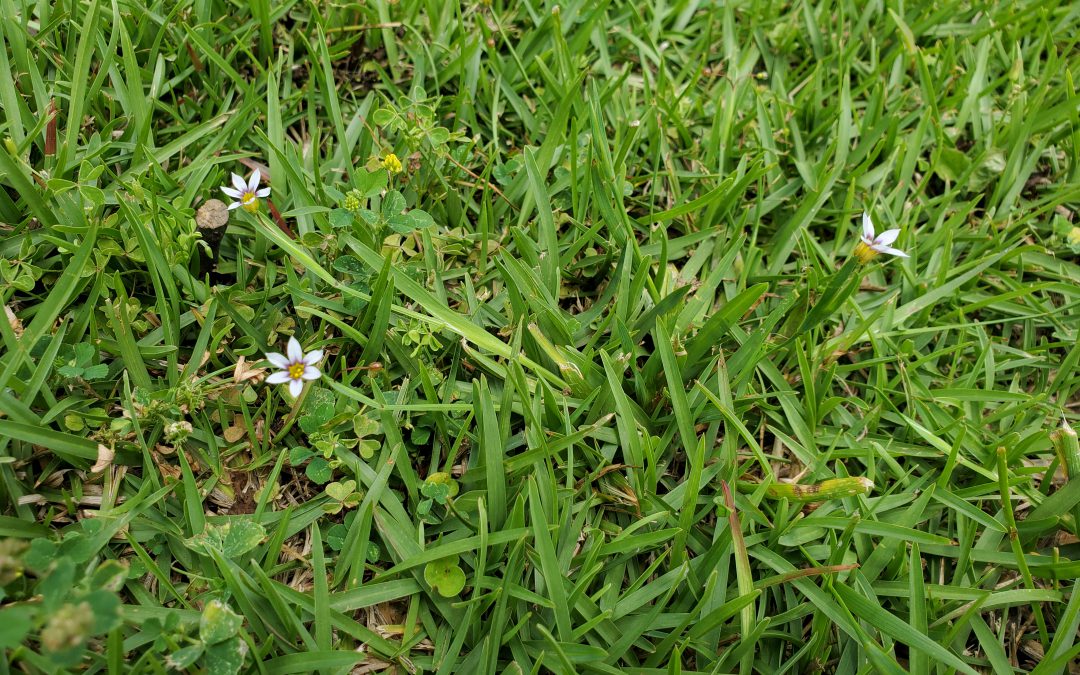
by Daniel J. Leonard | Apr 8, 2021
The line separating what is a weed and what isn’t often comes down to where the “weed” is growing and who is managing the area it’s growing in. Blue Eyed Grass (Sisyrinchium rosulatum), one of the most complained about lawn weeds this winter/spring falls squarely in that category! Native plant enthusiasts and homeowners looking to add native wildflowers to their landscape value the plant for its low maintenance, star-shaped blue blossoms in spring. Professional and home turfgrass managers, however, loathe the plant as it masquerades as grass to the untrained eye, looks messy in the cool months, and can displace turf during spring green up. While Blue Eyed Grass can be a pretty landscape plant, our focus today is on learning why it is such an annoying weed in turfgrass areas and exploring control options if it becomes a problem!
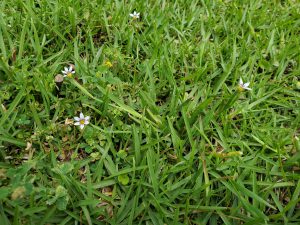
Blue Eyed Grass (Sisyrinchium rosulatum) in a Centipedegrass lawn in late March. Photo courtesy of Daniel Leonard.
For starters, Blue Eyed Grass (BEG) is not even a grass, though it does look an awful lot like one! It is actually a member of the Iris family and is more closely related to spring beauties like Gladiolus, Iris, and Crocus than any turfgrasses. The flowers, appearing late March through April, are a dead giveaway that we aren’t dealing with a grass, as are the flat leaves arranged in bunched fan-shaped rosettes. BEG is considered a winter annual plant in Florida, meaning it sprouts from seed in the fall, grows through the winter, then flowers and sets seed in the spring. Because it grows while lawn grass is dormant, it is very noticeable during its entire lifespan. Though BEG can tolerate a range of soil types, it prefers to grow in moist areas, making it right at home in Panhandle lawns and landscapes in the winter as we experience regular to excessive rainfall throughout our cool season.
All the above characteristics make BEG an annoying weed in lawns. It hides in turfgrass very well until the turf goes dormant in the dead of winter, leading most homeowners to ignore it until it becomes a problem in the spring. At this point, BEG is nearing maturity and is more difficult to control without damaging the turfgrass. BEG also thrives in our climate and can outcompete poorly managed turfgrass, especially if the lawn exhibits the soggy, compacted conditions that heavy lawn foot traffic and winter/spring rainfall cause. So, what is a homeowner to do?
The first step in controlling BEG is maintaining a healthy turf. Ensure you’re treating your turf well during the growing season by fertilizing appropriately, mowing frequently at the correct height, and irrigating properly. Sending turf into the dormant season stressed by poor growing season management is an invitation to winter weeds. Other cultural practices that can help mitigate troublesome winter weeds like BEG are periodic mowing during the cool season to prevent weeds from going to seed and being diligent about not frequently driving on, parking cars on, or otherwise excessively compacting the soil, a common cause of unhealthy turfgrass.
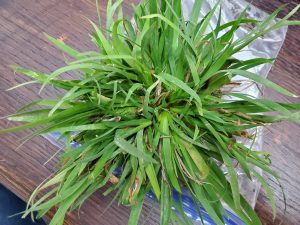
Blue Eyed Grass clump brought into the Calhoun County Extension office for identification and control recommendations in February 2021. Photo courtesy of Daniel Leonard.
After implementing the above cultural practices in your lawn management regime, you may also need chemical herbicides to achieve a clean cool season lawn. There are two basic options for BEG control. First, a fall (mid-late October) application of a pre-emergent herbicide like dithiopyr, prodiamine, or pendimethalin can be very effective at preventing winter weeds from occurring at all. If you happen to miss this fall pre-emergent application, a timely post-emergent application of 2,4-D or other general broadleaf herbicides works nicely as well. (BEG and other cool season weeds are best controlled with post-emergent herbicides in December and January before they mature and begin to set seed. Plan applications accordingly!)
While Blue Eyed Grass can be an attractive addition to the landscape, it is never welcome in turfgrass! To prevent this and weeds from becoming a problem, use smart cultural practices to maintain a healthy turf and make timely herbicide applications when needed. For more information on controlling Blue Eyed Grass and other winter weeds, contact your local UF/IFAS Extension office!
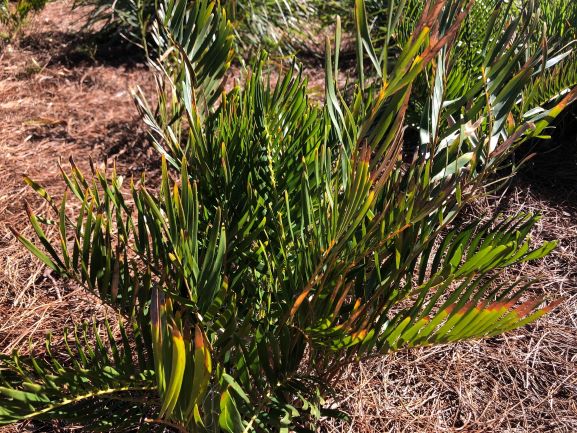
by Carrie Stevenson | Mar 11, 2021
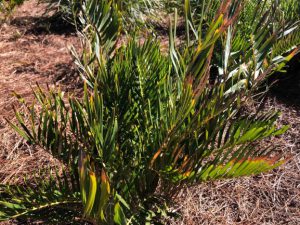
The ancient cycad, coontie, is a hardy and attractive plant for Florida landscapes. Photo credit: Carrie Stevenson, UF IFAS Extension
The plant has a crazy-sounding name, more like some little animal you’d find in Australia than a native plant. However, an ancient Florida plant it is, and a tough one at that. Growing close to the ground, it most resembles a large fern or a sago palm, if the sago had smooth, rounded leaf edges. Like the sago, the coontie (Zamia floridana) is a cycad—a group of palmlike plants that have been around so long that triceratops and stegasauruses ate them! Coonties are the only cycads native to North America, found in the states and island nations like Cuba and the Bahamas.
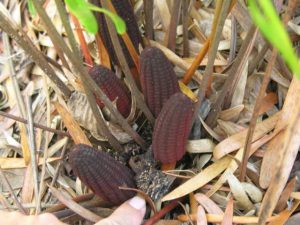
Male cones (strobilus) of coontie are thinner and shorter than female cones. Photo credit: Dan Culbert, UF IFAS
Another interesting feature of the coontie is its seed cones. These are large reddish orange cones that resemble magnolia seedpods. Both sexes of plant produce them in clusters ranging from one to five of the 2-7” long cones. Cones from the male produce pollen, while females produce seeds. If you are interested in attracting wildlife to your yard, the coontie provides good low-growing cover for birds and small mammals. It is also the preferred food for the caterpillar of the rare Atala butterfly. Members of the Timucuan and Calusa tribes ground up the starchy root of the coontie as a flour. However, the root contains a toxin and if it is not removed first, ingestion could result in severe abdominal pain and vomiting. From the late 1880’s through World War I, a large starch industry existed in Florida, producing flour from the coontie root.
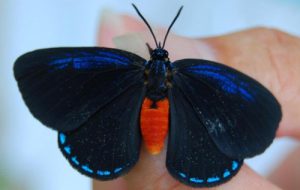
Adult female atala butterfly, showing royal blue streak on forewings. Photo credit: Sandy Koi, University of Florida
At home in drier soil conditions like oak hammocks and pinelands in north central Florida, these plants can also adapt to a variety of soil pH types. Coonties are drought, cold, and salt tolerant, thus a great landscape choice for coastal landscapes near the Gulf or a bay. The plants are very long-lived and adaptable. In fact, the book Florida’s Best Native Landscape Plants notes it is “Very hardy and easy to care for. Will grow well in any part of Florida, even outside its normal range. An exceptional replacement for the closely related, often used, but non-native sago palm.” In other words, this is an ideal landscape plant that should be used more throughout Florida.

















